Governments and societies around the world strive to improve their education systems and ensure that all children and youths have the opportunity to go to school and acquire the knowledge and skills they need to lead healthy and productive lives. Key inputs to the education system, such as curricula, teachers, and education infrastructure, help to improve the quality of education. The quality of education infrastructure, specifically its appropriate educational planning and design with a focus on child development, has been widely discussed in recent years. The Sustainable Development Goals, which are defined by the United Nations and scope the development agenda for all countries in the world, require countries to build and upgrade education facilities that are child, disability and gender sensitive, and provide safe, non-violent, inclusive, and effective learning environments for all. Many stakeholders around the world are seeking evidence on how various learning settings may positively or negatively affect child development. The Inter-American Development Bank (IDB), Organisation for Economic Co-operation and Development (OECD), United Nations Educational, Scientific and Cultural Organization (UNESCO), Council of Europe Development Bank (CEB), and the World Bank are doing analytical work to answer the question of how to design schools that are efficient, inclusive, and conducive to learning. Moreover, the World Bank and other international financial institutions have large and diverse investment portfolios on school infrastructure in different parts of the world, amounting to billions of United States dollars. Therefore, there is a need for more evidence on the effectiveness of these educational infrastructure investments. The potential benefits of improving the spaces where education is provided can be sizeable, including energy savings, safer and healthier environments for children, and better learning outcomes.
- ISBN10 1464813787
- ISBN13 9781464813788
- Publish Date 4 February 2019
- Publish Status Active
- Publish Country US
- Imprint World Bank Publications
- Format Paperback
- Pages 66
- Language English
